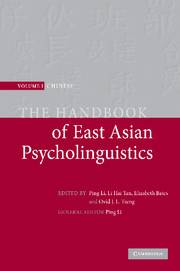Book contents
- Frontmatter
- Contents
- List of figures
- Notes on contributors
- Preface
- Introduction: new frontiers in Chinese psycholinguistics
- Part I Language acquisition
- Part II Language processing
- Part III Language and the brain
- 25 The relationship between language and cognition
- 26 Language processing in bilinguals as revealed by functional imaging: a contemporary synthesis
- 27 Specific language impairment in Chinese
- 28 Brain mapping of Chinese speech prosody
- 29 Modeling language acquisition and representation: connectionist networks
- 30 The manifestation of aphasia syndromes in Chinese
- 31 Naming of Chinese phonograms: from cognitive science to cognitive neuroscience
- 32 How the brain reads the Chinese language: recent neuroimaging findings
- Epilogue: a tribute to Elizabeth Bates
- References
- Name index
- Subject index
25 - The relationship between language and cognition
Published online by Cambridge University Press: 05 June 2012
- Frontmatter
- Contents
- List of figures
- Notes on contributors
- Preface
- Introduction: new frontiers in Chinese psycholinguistics
- Part I Language acquisition
- Part II Language processing
- Part III Language and the brain
- 25 The relationship between language and cognition
- 26 Language processing in bilinguals as revealed by functional imaging: a contemporary synthesis
- 27 Specific language impairment in Chinese
- 28 Brain mapping of Chinese speech prosody
- 29 Modeling language acquisition and representation: connectionist networks
- 30 The manifestation of aphasia syndromes in Chinese
- 31 Naming of Chinese phonograms: from cognitive science to cognitive neuroscience
- 32 How the brain reads the Chinese language: recent neuroimaging findings
- Epilogue: a tribute to Elizabeth Bates
- References
- Name index
- Subject index
Summary
The relationship between language and cognition
Perhaps because we think in words most of the time, language and thought seem quite inseparable (Vygotsky, 1986). Can we think without words? Does the language we speak shape the way we think? Or is it the other way around: do our perception and cognition shape our language?
Can we think without language?
Infants and older children seem able to think about important aspects of the physical world without language. By age 3 or 4 months, preverbal infants act as if they think that each solid object occupies its own space and so one object cannot go through another one (Baillargeon, 1993). Five-month-olds can count without words. If they see a hand carrying two objects to the back of a screen and reappearing empty-handed, they seem to expect two more objects behind the screen than before this addition event (Wynn, 1992). When they watch “magic shows” – created for these experiments – that violate basic principles of physics or numbers, preverbal babies would seem surprised and stare at such physically implausible scenes longer than they would at physically plausible ones. Some older children do not have any language because they are profoundly deaf and have not yet been exposed to any sign language. Nonetheless, they invent their own home signs and gestures to express their thoughts and needs (e.g. describing someone shoveling snow; asking someone to help them open a jar; see Goldin-Meadow & Mylander, 1990).
- Type
- Chapter
- Information
- The Handbook of East Asian Psycholinguistics , pp. 281 - 286Publisher: Cambridge University PressPrint publication year: 2006



